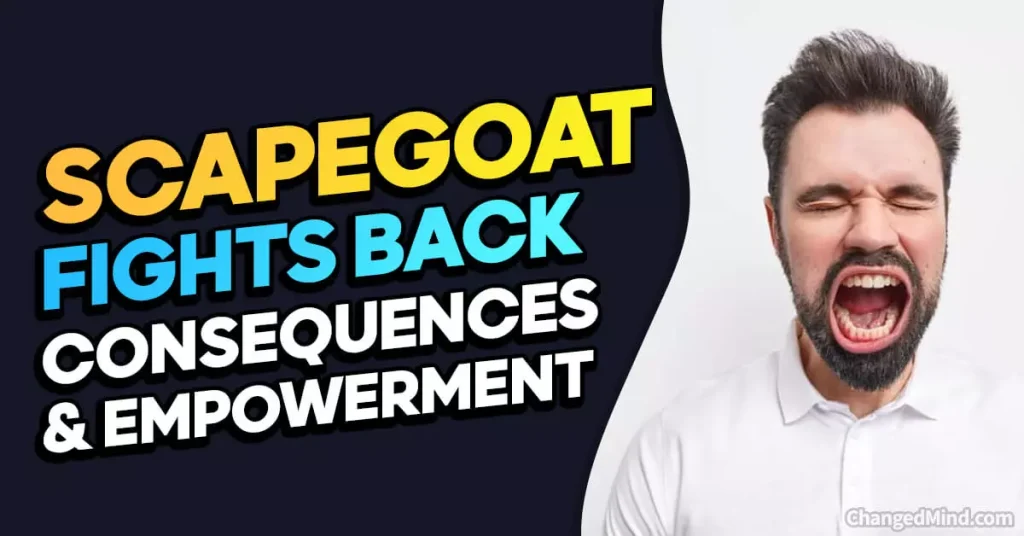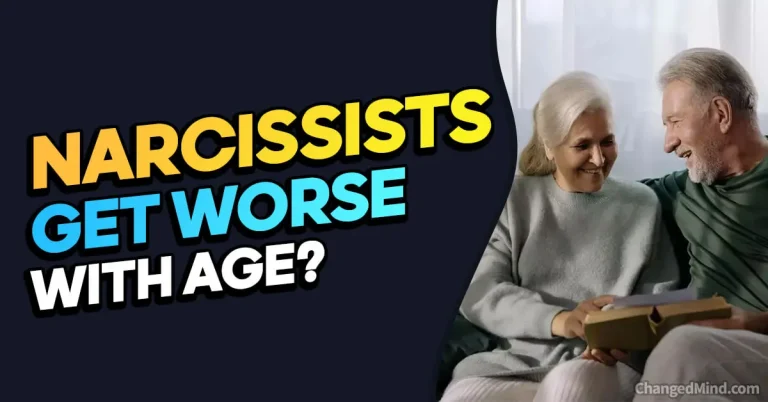Short answer: When the Scapegoat Fights Back, incredible transformations happen!
Discover the empowering journey of breaking free from the role of a scapegoat in this article.
We’ll provide you with 10 practical tips to overcome the challenges and regain your power. From coping mechanisms to assertiveness techniques, you’ll learn how to navigate the emotional toll, deal with backlash, and reclaim your self-worth.
Get ready for a life-changing ride! Keep reading to embark on your empowerment journey.
Key points:
- Understanding the scapegoat dynamic and its impact
- Catalysts for change and the breaking point
- Consequences and resistance faced when fighting back
- The power of empowerment and personal transformation
- Strategies and coping mechanisms to reclaim your power
- Support networks and resources for scapegoats on their journey
Welcome to a world where the underdog rises, the tables turn, and the scapegoat fights back! If you’ve ever found yourself in the role of a scapegoat, you know all too well the frustration, pain, and injustice that comes with it.
But fear not, for today we embark on a journey that explores the exhilarating transformation that occurs when the scapegoat finally decides to take a stand.
Defining the Scapegoat
In social and familial dynamics, a scapegoat is an individual who is unfairly blamed or made to bear the burden of others’ mistakes or misdeeds. They become the target of collective frustration, anger, or resentment, often serving as a convenient outlet for pent-up emotions. Whether it’s in the workplace, within families, or even in larger social groups, the scapegoat is all too familiar with the weight of undeserved blame.
The Empowering Act of Fighting Back
But here’s the exciting twist: the scapegoat fights back! The central theme of this article revolves around the awe-inspiring power that emerges when the scapegoat decides they’ve had enough. It’s a journey of self-discovery, resilience, and ultimately, empowerment. So fasten your seatbelts and get ready to witness the extraordinary consequences of the scapegoat standing tall against the tides of injustice.
Understanding the Scapegoat Phenomenon

Origins and Historical Context of Scapegoating
To truly grasp the significance of the scapegoat’s fight, let’s take a step back and explore the origins of this age-old phenomenon. Scapegoating is deeply rooted in human history, stretching back to ancient civilizations. The concept originated from ancient rituals where a designated individual would bear the sins, misfortunes, or transgressions of a community, symbolically purging them.
Throughout history, this practice transcended religious rituals and infiltrated various aspects of society. It became a way for individuals or groups to alleviate their own guilt, insecurities, or frustrations by projecting them onto a vulnerable scapegoat. This mechanism allowed the majority to preserve their unity and sense of righteousness, often at the expense of the scapegoat’s wellbeing.
Common Scenarios of Scapegoating
Scapegoating can rear its ugly head in numerous settings, leaving no social sphere untouched. The workplace, where ambition, competition, and power dynamics collide, is a breeding ground for scapegoating behaviors. In these scenarios, an individual may become the target of blame for team failures, workplace tensions, or even personal vendettas.
Within families, dynamics can sometimes devolve into scapegoating, as underlying tensions and unresolved conflicts find an outlet in the form of a family member who bears the brunt of blame for familial problems. Similarly, larger social groups, such as communities or even online spaces, can exhibit scapegoating tendencies when collective frustrations need a target.
Characteristics and Experiences of a Scapegoat
Identifying the scapegoat within a social dynamic is often a complex process, as it depends on various factors unique to each situation. However, certain characteristics and experiences are commonly associated with the scapegoat role. Here are a few to consider:
- Differentness: Scapegoats often stand out in some way, either due to their personality, beliefs, or unconventional choices. Their uniqueness becomes a source of discomfort for others, leading to their alienation and subsequent scapegoating.
- Empathy and Sensitivity: Scapegoats tend to be empathetic and sensitive individuals, capable of understanding others’ emotions and perspectives. Paradoxically, these very qualities make them vulnerable to becoming targets, as their emotional depth may be perceived as a threat or weakness.
- Blame Magnet: Scapegoats find themselves in a perpetual cycle of blame and criticism. They are frequently assigned responsibility for issues beyond their control, serving as an easy target for others to redirect their own insecurities or failures.
- Isolation and Exclusion: Scapegoating often leads to the scapegoat’s social exclusion. They may find themselves on the fringes, marginalized by others who distance themselves for fear of being associated with the blame placed upon them.
Understanding these characteristics and experiences helps shed light on the immense challenges faced by scapegoats, but it also serves as a crucial stepping stone towards their eventual fight back.
The Breaking Point: Catalysts for Change
Life as a scapegoat can be an emotional roller coaster, leaving you feeling drained, frustrated, and questioning your worth. However, there comes a time when something inside you snaps, and you find the courage to say, “Enough is enough!” Let’s dive into the factors that propel a scapegoat to fight back and the catalysts that ignite their determination.
Factors Leading to the Fight
Several factors contribute to the transformative journey of the scapegoat. These factors often accumulate over time, gradually building a sense of dissatisfaction and a desire for change. Here are some key elements that can lead you to take that brave step:
- Self-Reflection and Growth: As you navigate the scapegoat role, you begin to question the narrative imposed upon you. Self-reflection helps you recognize your own worth and challenge the unjust blame assigned to you. This newfound self-awareness becomes a powerful driving force for change.
- Emotional Resilience: Enduring scapegoating takes a toll on your emotional well-being. Yet, through the trials and tribulations, you develop a remarkable strength and resilience. The emotional toll becomes a catalyst for your fight back, as you refuse to let others define your identity.
Igniting the Determination
The path to challenging your role as the scapegoat is often sparked by specific triggers or events. These triggers ignite a fire within you, pushing you beyond the boundaries of acceptance and igniting your determination to fight back. Here are some common catalysts that fuel the flames:
- Unfair Treatment: A particularly egregious incident of blame or injustice can act as a turning point. It might be the proverbial “straw that broke the camel’s back,” propelling you to take action and reclaim your agency.
- Seeing Others’ Experiences: Witnessing the resilience and empowerment of others who have fought back against scapegoating can inspire and motivate you. Their stories become beacons of hope, proving that change is possible and encouraging you to follow in their footsteps.
Remember, the breaking point is different for everyone. It’s a deeply personal journey, driven by your unique experiences, strengths, and internal motivations. When the time is right, you’ll feel a shift within you, an indomitable spirit urging you to rise and challenge the narrative that has kept you confined.
So, brace yourself, because when the scapegoat fights back, they unleash a power that transforms not only their own life but also the very dynamics of the social group or organization that perpetuated their role. Get ready to witness the remarkable consequences that unfold when the underdog takes a stand!
What Happens in the Scapegoat’s Family or Among Coworkers?
Being a scapegoat doesn’t happen in isolation; it often unfolds within the dynamics of your family or workplace. Let’s take a closer look at what typically occurs in these settings and how the scapegoat’s fight back can impact these relationships.
Scapegoating in the Family
Within a family, scapegoating can be a deeply ingrained pattern that affects everyone involved. Here’s what commonly happens:
- Blame and Projection: The scapegoat becomes the target for blame, criticism, and negative projections. They are unfairly held responsible for the family’s problems, which creates a toxic dynamic.
- Role Reinforcement: Other family members may inadvertently or intentionally reinforce the scapegoat role. They might join in scapegoating, take on the role of enablers, or turn a blind eye to the injustice.
When the scapegoat fights back, the family dynamics can undergo significant shifts:
- Resistance and Denial: Family members who perpetuated the scapegoating behavior may resist the change. They may deny their roles in scapegoating or be unwilling to acknowledge the harm caused.
- Redistribution of Blame: Some family members may attempt to shift the blame onto others or avoid taking responsibility for their actions. They may struggle to adapt to the changing power dynamics within the family system.
- Healing and Transformation: In some cases, the scapegoat’s fight back can lead to healing and transformation within the family. It can prompt conversations, self-reflection, and a reevaluation of long-standing patterns. This process requires open communication, empathy, and a willingness to address past wounds.
Scapegoating in the Workplace
Similar dynamics can play out in a workplace setting, where scapegoating can occur within teams or organizational hierarchies. Consider the following aspects:
- Unfair Assignments and Criticism: Scapegoats often receive unfair assignments, excessive criticism, and blame for team or organizational failures. They may be unjustly targeted as the cause of problems or become the focus of workplace frustrations.
- Isolation and Marginalization: Scapegoats may find themselves isolated, excluded from important projects or decision-making processes. They may face social alienation and experience a lack of support from colleagues and superiors.
When the scapegoat fights back, the dynamics in the workplace can experience notable changes:
- Shifts in Perception: As the scapegoat challenges the assigned role, perceptions of their competence and credibility can evolve. Colleagues and superiors may begin to question preconceived notions and recognize the scapegoat’s talents and contributions.
- Cultural Impact: The scapegoat’s fight back can influence the workplace culture at large. It can shed light on toxic dynamics, encourage discussions about fairness and accountability, and inspire others to challenge unjust practices.
- Organizational Transformation: In some cases, the scapegoat’s fight back can prompt organizational changes. It can lead to policies that promote inclusivity, fairness, and psychological safety. This transformation benefits not only the scapegoat but also the entire workforce.
Remember, the impact of the scapegoat’s fight back varies depending on the specific circumstances and individuals involved. It’s important to navigate these situations with empathy, understanding, and a commitment to fostering healthy relationships and environments.
By standing up against scapegoating, you not only reclaim your own power but also contribute to a broader movement toward fairness, respect, and collective responsibility. Together, we can create families and workplaces where every individual is valued for their unique contributions and no one is burdened with unjust blame.
Common Things Narcissists Say When a Scapegoat Leaves
Leaving behind the role of a scapegoat can be a daunting but empowering decision. However, narcissists often respond in predictable ways when their scapegoat asserts their independence. Here are some common statements they make:
“You’re overreacting.”
Narcissists dismiss your attempts to break free by gaslighting you, making you doubt your own experiences and feelings. They downplay the impact of their actions and invalidate your emotions.
“You’re being selfish.”
When you prioritize your well-being and set boundaries, narcissists label you as selfish. They want to guilt-trip you into maintaining the status quo and suppress any signs of personal growth.
“You’re just seeking attention.”
Narcissists try to undermine your credibility by accusing you of seeking attention or playing the victim. They want to maintain control by diminishing your voice and experiences.
“You’ll never make it without me.”
Narcissists aim to instill fear and dependency by undermining your self-confidence. They try to make you believe that you’re incapable of succeeding or finding happiness without them.
“You’ll regret this.”
Narcissists resort to threats, manipulation, and intimidation to regain control. They want to deter you from leaving by instilling fear of the unknown and consequences they might impose.
Remember, these statements are tactics employed by narcissists to maintain their power and control over you. Recognizing their strategies is essential to breaking free and reclaiming your life.
As you navigate the aftermath of leaving, surround yourself with supportive networks, seek professional guidance, and prioritize self-care. Remember, your journey towards personal growth and empowerment is worth every step, and there is a world waiting for you beyond the confines of the scapegoat role.
The Consequences of Standing Up
When you, as the scapegoat, summon the courage to fight back, prepare yourself for a whirlwind of reactions and consequences. Your act of empowerment disrupts the established order, challenging those who perpetuated scapegoating behaviors. Let’s dive into the aftermath of your courageous stand and the ripple effects it creates within the social group or organization.
Immediate Reactions and Responses
The moment you step out of the role assigned to you, reactions from others can vary greatly. Here are some common responses you might encounter:
- Surprise and Denial: The individuals who scapegoated you may find themselves taken aback by your newfound assertiveness. They might deny their involvement or attempt to downplay the impact of their actions.
- Resistance and Pushback: Some may resist your fight for change, unwilling to relinquish their power dynamics. They may attempt to undermine your credibility or dismiss your concerns, hoping to maintain the status quo.
Backlash and Attempts to Maintain the Status Quo
Challenging the scapegoating dynamic threatens the equilibrium that some individuals strive to preserve. Consequently, you might face backlash and resistance as they strive to maintain the existing power structures. Here are a few examples of what you might encounter:
- Deflection and Redirection: Those who perpetuated scapegoating behaviors may deflect blame onto others or redirect attention away from the issues you raise. They might attempt to shift the narrative, painting themselves as victims or distorting the truth to protect their own interests.
- Isolation and Ostracization: Standing up against scapegoating can sometimes lead to social consequences. You may experience increased isolation as individuals distance themselves from you to avoid being associated with the changes you’re advocating for.
Ripple Effects on Relationships and Dynamics
Your fight back reverberates through the social group or organization, leaving a lasting impact on relationships and dynamics. Here’s what can happen:
- Awakening Others: Your act of empowerment serves as an inspiration for others who may have also felt the weight of scapegoating. By challenging the status quo, you encourage them to question their own roles and initiate change.
- Transformation of Power Dynamics: As the scapegoat fights back, the power dynamics within the social group or organization undergo a seismic shift. Your actions challenge the hierarchies and norms, prompting a reevaluation of how blame and responsibility are assigned.
Remember, the consequences of standing up are not always immediate or straightforward. It’s a complex and ongoing process, one that may demand resilience and perseverance. Yet, your courage to challenge the scapegoating dynamic brings the potential for profound and positive change, both for yourself and the entire social ecosystem you inhabit.
The Power of Empowerment and Transformation
When you summon the courage to fight back as a scapegoat, remarkable changes unfold, both within and around you. It’s a journey of self-discovery, resilience, and transformation. Let’s explore the empowering effects that come with standing up against scapegoating and the positive shifts you can experience.
Embracing Self-Awareness
One of the profound changes that occur when you fight back as a scapegoat is an increased sense of self-awareness. Through the process of challenging the narratives imposed upon you, you begin to question the validity of the blame assigned to you. This introspection leads to a deeper understanding of your own worth, strengths, and values. It’s like peeling away the layers of false accusations to reveal your authentic self.
Building Self-Esteem
Escaping the clutches of scapegoating paves the way for a boost in self-esteem. As you refuse to accept the blame that doesn’t belong to you, you recognize your inherent value and worthiness. You shed the negative labels that were once imposed upon you, replacing them with a newfound confidence in your abilities. This growing self-esteem becomes a sturdy foundation upon which you can rebuild and thrive.
Cultivating Assertiveness
When you fight back as a scapegoat, you tap into a wellspring of assertiveness. No longer confined by the expectations and narratives imposed upon you, you develop the ability to assert your thoughts, feelings, and boundaries with clarity and conviction. This assertiveness allows you to navigate relationships and social dynamics with greater autonomy and confidence. It’s like discovering a superpower you never knew you had.
Tales of Transformation
Throughout history, countless individuals have risen from the scapegoat role, defying the odds and transforming their lives. Their stories serve as beacons of hope, illustrating the profound impact that fighting back can have. Here are a few inspiring examples:
- Rosa Parks: By refusing to give up her seat on a segregated bus, Rosa Parks fought back against racial discrimination and sparked the Civil Rights Movement. Her act of defiance challenged the status quo and paved the way for significant social change.
- Malala Yousafzai: After surviving a targeted attack by the Taliban for advocating girls’ education, Malala Yousafzai emerged as a powerful voice for human rights. She fought back against oppression and became the youngest Nobel Prize laureate, inspiring millions worldwide.
These individuals demonstrate the incredible resilience and strength that lies within each scapegoat who fights back. While their journeys may be extraordinary, they serve as a reminder that transformation is possible for anyone willing to challenge their role and reclaim their power.
Remember, your fight back as a scapegoat can be the catalyst for personal growth, empowerment, and a journey towards a brighter future. As you embrace self-awareness, cultivate self-esteem, and unleash your assertiveness, you pave the way for a life liberated from the shackles of scapegoating.
What Happens to the Scapegoat?
Being a scapegoat can take a significant toll on your well-being and overall life experience. However, when you decide to fight back, a transformative journey begins. Let’s explore what can happen to the scapegoat along this empowering path.
Reclaiming Personal Power
By fighting back, you take a crucial step in reclaiming your personal power. You refuse to accept the role assigned to you and challenge the unfair dynamics that have kept you in victimhood. This process involves:
- Self-Awareness: Gaining a deeper understanding of how scapegoating has affected you and recognizing the patterns and dynamics at play.
- Self-Esteem: Building and strengthening your self-esteem by acknowledging your worth, talents, and unique qualities that have been overshadowed by the scapegoat role.
- Assertiveness: Developing assertiveness skills to express yourself confidently, set boundaries, and advocate for your needs and rights.
Consequences and Transformation
When the scapegoat fights back, several consequences and transformative changes unfold:
- Shifting Dynamics: The fight back disrupts the established power dynamics within the family, workplace, or social group. Others may need to reevaluate their own roles and behaviors, leading to a potential transformation in relationships.
- Backlash and Resistance: Expect some resistance from those who are invested in maintaining the scapegoating dynamics. They might resist your efforts, attempt to discredit you, or even intensify their scapegoating tactics. Stay resilient and seek support during these challenging moments.
- Emotional Liberation: The act of fighting back can provide a sense of emotional liberation and freedom. You no longer carry the burden of unjust blame and can explore a more authentic and fulfilling life.
Growth and Personal Empowerment
As you navigate the journey of fighting back, you will experience personal growth and empowerment:
- Healing and Resilience: The process of standing up for yourself can contribute to healing past wounds and cultivating psychological resilience. It allows you to confront and process the emotional impact of scapegoating, leading to personal transformation and growth.
- Empowerment Journey: Your fight back becomes an empowering journey of self-advocacy and self-discovery. Along the way, you may discover new strengths, skills, and capacities that contribute to your overall growth.
- Breaking Free: Ultimately, by fighting back, you break free from the constraints of the scapegoat role and the limitations it imposed. You open yourself up to a world of possibilities, where personal growth, self-expression, and authentic connections are within reach.
Expert Says
Emily Simonian, LMFT
Licensed Marriage and Family Therapist, Thriveworks

Remember, the journey of the scapegoat fighting back is unique for each individual. Seek support, practice self-care, and embrace the process of personal empowerment. By reclaiming your power, you set a powerful example for others and contribute to dismantling the destructive dynamics of scapegoating.
Strategies for Empowering the Scapegoat
As a scapegoat who is ready to reclaim your power, it’s important to equip yourself with practical strategies and tools. Here are some valuable tips and advice to support you on your journey of empowerment:
Reclaiming Your Power
- Recognize Your Worth: Remind yourself that you are not defined by the blame others place upon you. Acknowledge your inherent value and worthiness as an individual, irrespective of the narratives imposed upon you.
- Challenge Negative Beliefs: Identify and challenge the negative beliefs that have been internalized due to scapegoating. Replace them with positive affirmations and thoughts that reinforce your strengths and abilities.
- Set Boundaries: Establish clear boundaries to protect yourself from further scapegoating. Communicate your boundaries assertively and firmly, ensuring that others respect your limits.
Coping Mechanisms and Assertiveness Techniques
- Emotional Regulation: Develop healthy coping mechanisms to manage the emotional toll of scapegoating. Engage in activities that bring you joy, such as hobbies, exercise, or mindfulness practices. Seek professional support, like therapy or counseling, to process your emotions and develop effective coping strategies.
- Assertiveness Training: Enhance your assertiveness skills to navigate difficult conversations and assert your needs. Practice clear and direct communication, using “I” statements to express your thoughts and feelings assertively. Remember, assertiveness is about advocating for yourself while respecting the rights and boundaries of others.
- Self-Care Practices: Prioritize self-care to nurture your overall well-being. Engage in activities that promote relaxation, self-reflection, and self-compassion. This can include activities such as journaling, meditation, spending time in nature, or connecting with supportive friends and family members.
Resources and Support Networks
- Therapeutic Support: Consider seeking therapy or counseling to work through the emotional impact of scapegoating. A trained professional can provide guidance, support, and tools to help you heal and navigate the challenges you face.
- Support Groups: Joining support groups or online communities can connect you with others who have experienced similar struggles. Sharing experiences and insights with individuals who understand your journey can be immensely empowering and validating.
- Educational Resources: Educate yourself about scapegoating dynamics, assertiveness, and self-empowerment. Books, podcasts, and articles on related topics can offer valuable insights, practical advice, and inspiration.
Remember, empowering yourself as a scapegoat is an ongoing process that requires patience and self-compassion. Embrace your journey, knowing that by standing up and fighting back, you are breaking free from the confines of victimhood and embracing personal growth and resilience.
Take each step at your own pace, seek support when needed, and celebrate your progress along the way. You are not alone, and there is a vibrant community of individuals who have fought back and transformed their lives. Together, we can build a world that values empathy, inclusivity, and the empowerment of every individual, free from the chains of scapegoating.
Conclusion
Congratulations on completing this journey from victimhood to empowerment. By mustering the courage to fight back as a scapegoat, you have embarked on a path of self-discovery, resilience, and personal growth. Let’s recap the key takeaways and emphasize the importance of empathy, understanding, and collective responsibility.
A Journey of Empowerment
Throughout this article, we explored the plight of the scapegoat and the transformative power of fighting back. We delved into the origins and scenarios of scapegoating, understanding the characteristics and experiences of a scapegoat. We examined the catalysts that ignite the determination to challenge the role and discussed the consequences faced by those who dare to fight back.
From recognizing your worth and cultivating self-awareness to embracing assertiveness and reclaiming your power, you discovered practical strategies for empowerment. Coping mechanisms, support networks, and self-care practices became essential tools in your arsenal. The examples of inspiring individuals who broke free from the scapegoat role demonstrated the potential for personal growth and transformation.
Empathy and Understanding
As we conclude, it’s important to cultivate empathy and understanding towards scapegoats. Recognize that scapegoating dynamics can have a profound emotional and psychological toll on individuals. Extend compassion to those who have experienced this role, understanding that they are not to blame for the injustices imposed upon them.
By educating ourselves and fostering empathy, we can challenge societal norms that perpetuate scapegoating and foster a culture of inclusivity, respect, and support. Let us strive to be allies, offering a listening ear, and standing up against injustice wherever it may manifest.
Collective Responsibility
Dismantling scapegoating dynamics is not solely the responsibility of the scapegoat; it is a collective effort. It requires us to examine our own biases, question societal norms, and challenge the narratives that enable scapegoating behaviors. By embracing collective responsibility, we can create spaces where everyone feels seen, heard, and valued.
Remember, your fight back as a scapegoat has the power to inspire others and contribute to a larger movement for change. Your journey is not only about personal growth but also about creating a ripple effect that challenges the status quo.
So, as you continue on your path of empowerment, know that you are not alone. Seek support, share your story, and join forces with like-minded individuals who are fighting against scapegoating in all its forms. Together, we can build a world where the scapegoat’s fight back becomes a catalyst for societal transformation, and where personal growth and resilience triumph over victimhood.
Keep fighting back, standing tall, and embracing your journey of personal growth and empowerment. The world needs your voice, your strength, and your story.
FAQ
What are some coping mechanisms that can help a scapegoat when they fight back?
Coping mechanisms like seeking therapy, practicing self-care, and engaging in support networks can provide the necessary tools to navigate the emotional toll and challenges of fighting back as a scapegoat.
Can fighting back as a scapegoat lead to improved relationships within the family or workplace?
Yes, the fight back can lead to positive shifts in relationships. It may prompt healing conversations, increased understanding, and a reevaluation of dynamics, potentially transforming family or workplace dynamics for the better.
How can assertiveness techniques benefit a scapegoat who fights back?
Assertiveness techniques empower the scapegoat to express their thoughts, feelings, and boundaries clearly and confidently. This assertive communication fosters self-respect and can prompt others to recognize the scapegoat’s rights and perspectives.
Is it possible to break free from the scapegoat role and experience personal growth?
Absolutely. By challenging scapegoating narratives, embracing self-awareness, and reclaiming personal power, individuals can break free from the scapegoat role, leading to personal growth, increased self-esteem, and a stronger sense of identity.
Are there any support networks available for scapegoats who decide to fight back?
Yes, there are support networks, both online and offline, that provide a sense of community, validation, and guidance for scapegoats. These networks offer understanding, resources, and a space to share experiences and insights with others who have faced similar challenges.

Disclaimer
This information is for educational purposes only and is not intended to be a substitute for clinical care. Please consult a health care provider for guidance specific to your case.






